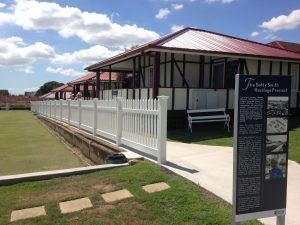Opened in 1936 by then-Governor Sir Lesley Orme Wilson, the Chermside Garden Settlement was a visionary project. Conceived by the Rev. Harold Manuel Wheller and largely funded by philanthropist George Marchant (of soft drink fame), the first 20 cottages and two central buildings offered home-like accommodation for the elderly.
This was a ‘dream’ project for any historian. Initially my contract covered writing the text and locating images for interpretation panels to be installed in three restored 1936 cottages. These cottages, each of two larger rooms plus a gutted bathroom, comprise the Betty Smith Heritage Precinct, named for a generous benefactor whose funds made the entire project possible.
My contract eventually expanded to include coordinating with staff and reviewers to finalise content, dealing with the exhibition designer (the respected and experienced Brandi Projects) about interpretation panel designs and furniture layouts, working with volunteers, and even sourcing appropriate music to play on an old radio.

Wesley Mission Queensland offered support via a steering committee and support staff. A volunteer group was pulled together; volunteering is a strong ethos among the retirees living at Wheller Gardens. Their tasks ranged from trawling Trove for useful newspaper articles, to scouring the regular Wheller Gardens jumble sales for needed display props, and propagating plants for the gardens surrounding the cottages. The volunteers will also open the cottages for public visits.
The exhibition designers developed design concepts for the interpretation panels, and fabricated and installed them to a very tight schedule. Brandi Projects also manufactured several special items, such as a new audio system to be installed into the body of an old cabinet radio. Governor Paul de Jersey would open the precinct 80 years to the day of the original opening, so timing and preparation were all-important.
An open-ended project brief meant that I had leeway to choose the stories to tell, and how to interpret them. The final display was shaped to some extent by the artefacts found – some 1936 furniture was unearthed from storage, framed photographs and paintings were located, and props were collected. We decided on one theme per cottage, and how to use the former bathrooms which were too small for comfortable reading of panels.
What more can a working historian ask for – fabulous clients, great support from fellow professionals, and the opportunity to drive a project from start to finish?
Judith Nissen
